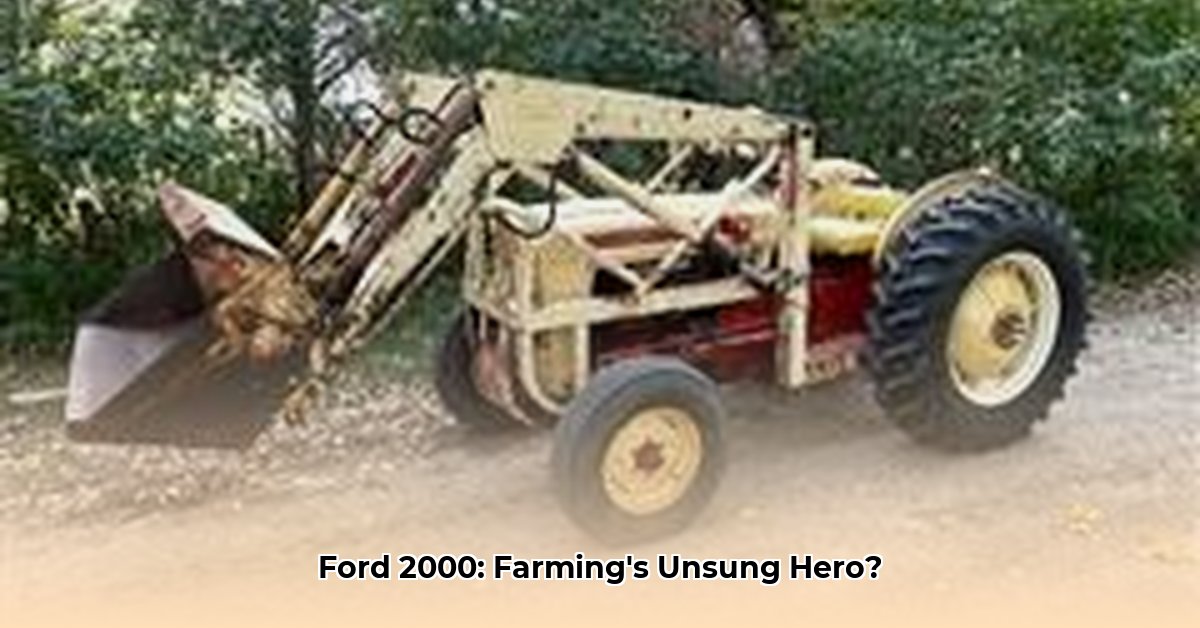
Mechanization's Early Steps: Efficiency and its Unseen Costs
The Ford 2000 tractor, a stalwart of mid-20th-century agriculture, revolutionized farming efficiency. Larger fuel tanks reduced refueling stops, improved hydraulics streamlined tasks, and power steering minimized operator fatigue. This increased productivity was a boon for farmers, allowing them to cultivate more land in less time. However, this efficiency came at a cost: increased fuel consumption and, consequently, higher greenhouse gas emissions. How did the increased productivity compare to the environmental impact? This is a question that needs revisiting using modern metrics. For detailed specifications, see the Ford 2000 specs.
Environmental Concerns: A Necessary Trade-off?
The Ford 2000, reliant on gasoline or diesel, contributed significantly to air pollution. While precise emissions data for the Ford 2000 are scarce, its environmental footprint was undeniably larger than modern counterparts. This highlights a critical question facing agriculture: how do we balance the need for increased food production with environmental stewardship? The Ford 2000 serves as a potent reminder of the inherent trade-offs between agricultural advancements and ecological impact. What sustainable solutions emerged in response to concerns raised by technology like the Ford 2000?
Versatility and Limitations: A Jack-of-All-Trades?
The Ford 2000's versatility was a key factor in its success. Its adaptability to various implements, from front-end loaders to backhoes, made it a valuable asset for diverse farming operations. This multi-functional design was particularly advantageous for smaller farms with varying crop needs. However, the absence of a power take-off (PTO) in some models limited its compatibility with certain machinery. Furthermore, maintenance demands were arguably higher than those of modern equipment. Did the increased flexibility outweigh these limitations? A thorough analysis is needed to answer this question definitively.
Technological Leaps and the Path to Sustainable Intensification
One significant improvement in later Ford 2000 models was the transition to multi-speed transmissions, offering up to twelve speeds compared to the four unsynchronized speeds of earlier versions. This advancement, alongside features like "Select-O-Speed," dramatically improved operational efficiency. This evolution reflects the broader trend toward "sustainable intensification" – producing more food with fewer resources. This technology shift had profound implications for farming practices and the design of agricultural machinery. How did the increased speed and efficiency of these upgraded models impact the overall sustainability of farming practices?
Analyzing the Ford 2000's Ripple Effects: Multiple Perspectives
The Ford 2000's impact extended far beyond the farm. Its influence is still felt across various sectors.
| Stakeholder | Short-Term Impact (0-1 year) | Long-Term Impact (3-5 years and beyond) |
|---|---|---|
| Agricultural Historians | Documented a critical stage in agricultural mechanization, observing significant productivity gains. | Analyzed its role in shaping modern farming practices and compared it with contemporary sustainable methods. |
| Sustainable Farming Advocates | Highlighted the environmental consequences of early mechanization, focusing on fuel use and emissions. | Promoted sustainable alternatives, such as precision agriculture and renewable energy-powered equipment. |
| Equipment Manufacturers | Experienced increased demand, driving innovation in design and efficiency. | Focused on Research & Development in eco-friendly and high-performance agricultural technologies. |
| Policy Makers | Noticed the shift towards large-scale farming and its related environmental challenges. | Implemented policies to encourage sustainable agriculture practices, such as incentives for efficient machinery. |
Comparing Ford 2000 Tractor Fuel Efficiency to Modern Sustainable Alternatives
The Ford 2000's fuel efficiency is difficult to quantify precisely due to the absence of readily available standardized data. Factors like engine condition and workload varied considerably. However, modern tractors exemplify a significant advance in fuel efficiency and reduced emissions thanks to advancements such as Tier 4-compliant engines and hybrid systems. These offer substantial improvements in both fuel consumption and environmental impact over their predecessors. This comparison highlights the remarkable progress made in sustainable agricultural technology.
Key Takeaways:
- The Ford 2000’s legacy provides valuable insights into the evolution of agricultural machinery.
- Modern tractors offer substantially improved fuel efficiency and reduced emissions.
- A comprehensive comparison requires considering all aspects of sustainability, not just fuel consumption.
- Continued innovation strives to achieve greater operational efficiency and environmental responsibility in agriculture.
https://www.tractordata.com/industrial-tractors/000/0/6/68-ford-2000.html